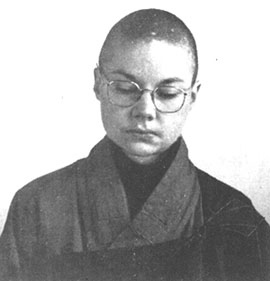|
Having "proved" herself by
making "aristocratic" friends, gaining academic recognition,
popularity, and the good life, Heng Hsien graduated from the University of
California, Berkeley, with a B.A. in Comparative Literature with honors, the
Departmental Citation, and a Phi Beta Kappa Key. A Brandeis University
fellowship followed which led to a Master's Degree in one year, and the opening
of insights which left her dissatisfied with course work and searching for a
teacher. She returned to graduate school at Berkeley.
She began pouring over Indian and Chinese
philosophy and randomly adopted their schools of practice but no system seemed
right for long, she still thought she had to learn everything and devise her own
eclectic philosophy; she had no idea she could ever have full faith in a single
teacher. Her mother died of cancer and Heng Hsien chose to stay with her father
rather than accept a Bryn Mawr fellowship offered to her.
Later she wandered through Europe and
North Africa again, and then returned to U.C. Berkeley for a Ph.D. and a last
ditch attempt to "salvage what mattered to me from an education system that
I felt was somehow 'closing over' and soon to become Inaccessible to spiritual
aspirants." She felt the desire to gain whatever was left of that kind of
scholarly competence while there was still time.
By 1969 Heng Hsien's interests were
focusing on Buddhism and that fall she met Upasaka I Kuo-jung in a Sanskrit
class at U.C. Berkeley. He told her of the Venerable Abbot of the Buddhist
Lecture Hall in San Francisco and gave her a copy of the first issue of Vajra
Bodhi Sea. That summer Heng Hsien attended a special study session on South Asia
at the University of Washington in Seattle and concentrated her study on the
Heart Sutra. Among reference materials recommended to her were the Venerable
Master Hua's Standless Verses and commentary on the Sutra.
That fall upon her return to San
Francisco, Heng Hsien went to the Buddhist Lecture Hall and on her second visit
during the evening lecture on the Lotus Sutra, although she didn't understand
Mandarin Chinese at the time, she had the distinct feeling at one point that the
Master was talking directly to her. When the translation of that portion of the
lecture was made and reached the same point, she learned that the Master had
been quoting the Heart Sutra. Heng Hsien began to attend lectures more and more
regularly and started taking careful notes, a practice she still never neglects.
She began to give her income for the support of the Monastery, saving only the
minimum to cover her own living expenses.
During the summer of 1971 after Gold
Mountain Monastery was established, Heng Hsien came to San Francisco to live to
draw near the Master and his teachings. In the middle of the summer session of
1971 she received the precepts of a Sramanerika. Heng Hsien began serious study
of Chinese and also commenced teaching languages at the Monastery including
Sanskrit, German, and Portuguese--all the while looking to her dissertation
which dealt with a Sanskrit portion of the Avatamsaka Sutra.
In the spring of 1972 Heng Hsien passed
her Ph.D. orals and immediately turned her full attention to the intensive
precept platform held at Gold Mountain Monastery during that summer which led to
her full ordination as a bhiksuni on August 8th, 1972. She became the first
woman to receive the Complete Precepts of the Thousand Buddhas on American soil.
In 1972, with issue number twenty-one of Vajra Bodhi Sea, Heng Hsien began
writing a Sanskrit lesson for each issue. During that time she also taught a
course in Indian Civilization at U.C. Berkeley as a part-time Acting Instructor.
She also became an active member of the Buddhist Text Translation Society,
editing The Amitabha Sutra and the Vajra Sutra texts and commentaries.
In 1974 Heng Hsien joined the group of
translators who give on-the-spot translations into English of the Venerable
Master's Sutra lectures and Dharma talks. In the late spring of 1975 Heng
Hsien's Ph.D. dissertation was submitted and approved. At present Heng Hsien is
working on a translation of National Master Ch'ing-liang’s Preface to The
Avatamsaka Sutra.
|
